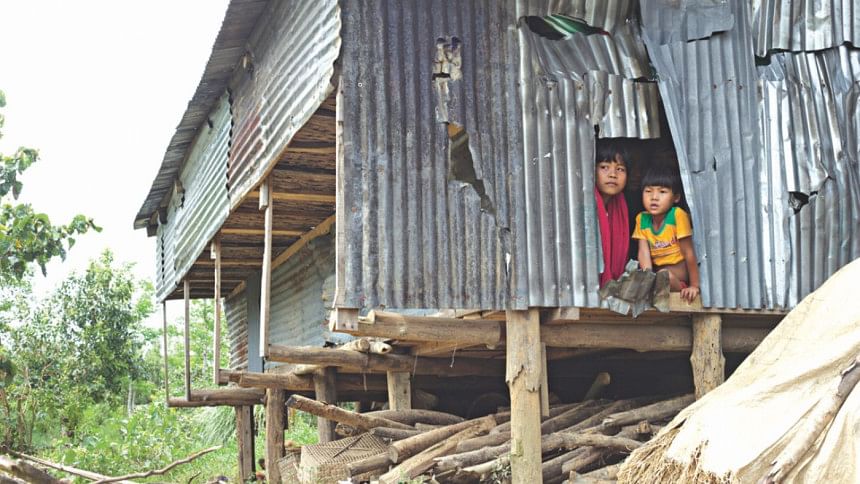Langadu, after the flames

A recent exhibition at Drik Gallery, 'Phoenix of Langadu,' reminded me again of the horror with which we witnessed the burning of three villages in Langadu upazila of Rangamati, only a little less than six months ago. That, I assume, was the intent of the exhibition of photographs depicting the aftermath of the attacks—to remind us that after the flames were doused, things did not just revert to normalcy.
It is difficult to comprehend the scale of the attack by Bengali settlers on hundreds of indigenous houses and shops. When one's house is razed to the ground along with all possessions, where does one go? How exactly does one carry on, with no roof above one's head, and the perpetrators unpunished? It cannot be lost on anyone that an attack such as the one in Langadu leaves traces which echo for months in the form of homelessness, food insecurity, having to rebuild lives from the ground up—not to speak of the trauma and fear that such an incident instils.
But, as happens in the world, we forgot Langadu. The Rangamati landslides, the flash floods, the influx of Rohingya refugees followed one after another, and in trying to cope and deal with each, the limelight shifted from the previous crises. So, six months later, it is pertinent to ask, how is the Chakma community in Langadu carrying on?
Mrittika Kamal, one of the curators of Phoenix of Langadu, says, not very well. Newspapers in June, when the attacks happened, reported that in despair and desperation the community initially refused to take any government aid. They were then assured of forthcoming help in the form of food, and money to rebuild their homes. But Mrittika, who has been in contact with the community trying to help in whatever way possible, says there has been no relief sent to the community since July 12. Beyond the initial aid of two bundles of corrugated tin, Tk 6,000, two eiderdowns and 30kg rice given to each family, there was no further help to the community from the government.
"The case of Langadu is one of administrative failure to protect citizens of a country from indiscriminate hate attacks. The community, foreseeing a turn for the worst, had asked for the help of the authorities, to no avail.
Speaking to those affected reveals a similar frustration. Moni Shankar Chakma, who lost everything in the attacks, says that on top of the government aid mentioned above, they were given a further Tk 24,000 and Tk 11,000 by UNDP and Somaj Kallyan Parishad respectively. For a community that lost everything it had, the total sum is not enough to rebuild their houses and ensure their daily needs. Moni Shankar also points out that the government had promised that it would rebuild their houses—a promise that is yet to be fulfilled.
Many of the families are now residing at rented houses, shelters or at the homes of extended families. For those staying in shelters, another problem has popped up. Moni Shankar points out that the families had been staying in two schools-turned-shelter-houses. But with JSC examinations coming up, they have had to evacuate the premises.
Mrittika points out another issue that needs attention: the problem in the way the total number of families affected was determined. Based on the number of households burnt, the number of families to receive help was determined to be 224. However, what this fails to take into account is that in some households there was more than one family residing. Some families were living in rented houses, in which case only the owner of the house was included in the list. Of course, the possessions that got burnt during the attacks belonged to the residing families. It remains unclear if they will receive any form of compensation. The Langadu attacks left almost nothing. Crops were burnt, and of course, then came the rain. The yield is gone, and most families are living on potatoes collected from the forests for now, says Mrittika. These issues need immediate attention.
Of course, the aftermath of communal attacks is not only felt through privations. Fear—reminiscent of the communal attack by Bengalis on the Chakma community in Langadu in 1989, which saw 36 indigenous people brutally murdered—has taken root again. Moni Shankar and Mrittika both point out how the people are still traumatised. Children especially, have been affected. Since most schools are in Bengali-majority areas, many refuse to even go to school. At home, living with the trauma of what they recently witnessed, they cannot pay attention to their studies. Even for those who would want to continue studying, the fire took their books, school supplies and uniforms. The government has provided the textbooks, but they are still without any means to pay for the rest.
That we have failed to ensure the immediate needs of these people should tell us how well we have addressed the bigger underlying issues. The events that led up to the attack raise many questions. For those who have forgotten, it all allegedly started with the death of one Nurul Islam Noyon, organising secretary of the upazila Jubo League. He was found murdered and his motorcycle was stolen. Even before any investigation, a rumour started and spread like wildfire that it was indigenous individuals who were to blame.
Noyon's family had initially wanted to hold his janaza close to their house, but the whole thing was used by some influential individuals to mobilise communal hatred. They insisted that the janaza be held on a grand scale. Remembering the events of 1989, the indigenous community leaders in Langadu had met with the administration, the police and the security forces, only to be assured there was nothing to fear. What followed was a funeral procession of Bengalis demanding punishment of "indigenous criminals" turned violent. They started attacking shops and houses, razing them to the ground. Anything that could be looted—televisions, refrigerators, sewing machines—were taken.
After the event, the National Human Rights Commission (NHRC) formed a three-member fact-finding committee over the arson attack. Banchita Chakma, a honorary member of NHRC and head of the committee, speaking to us points out that the attacks highlighted some crucial things that she as a teacher in that community had been noting with distress for some time. Bengalis had been living in indigenous-majority areas for a very long time. But, what characterises the atmosphere today is one of distrust and intolerance. She also points out that children are being brought up in a communal environment, and that there is a role of families in fostering this attitude.
On top of that, there is the plague of impunity: every time something like this happens, we see a few arrests and nothing more. That the Langadu attacks were well-organised and coordinated is beyond a doubt. In areas which had shops of Bengali and indigenous people, only the latter were razed. Mrittika points to an example where the furniture belonging to the Bengali owner was first taken out before setting the shop on fire. This is vendetta, and it sparked off from perpetuated rumours that some indigenous youth were to blame for Noyon's death. Even if it were the case, the fact that it resulted in wholesale destruction of an entire community speaks of the intolerance and communal sentiment that is at the heart of the matter.
The case of Langadu is one of administrative failure to protect citizens of a country from indiscriminate hate attacks. The community, foreseeing a turn for the worst, had asked for the help of the authorities, to no avail. And the pattern of violence and its aftermath is always the same: unsubstantiated rumours, coordinated mass attacks, looting, vague assurances of justice and aid, and then relegation to the back of the mind. We saw this in the attack on the Hindu community in Nasirnagar and in the attack on the Santal village in Gaibandha this year. Clearly, we have failed to address the root of the problem if we are bound to witness a repeat of it every few months. For now, let us hope the immediate needs—that of food, shelter and education for children—will at least be provided for.
Moyukh Mahtab is a member of the editorial team at The Daily Star.





Comments